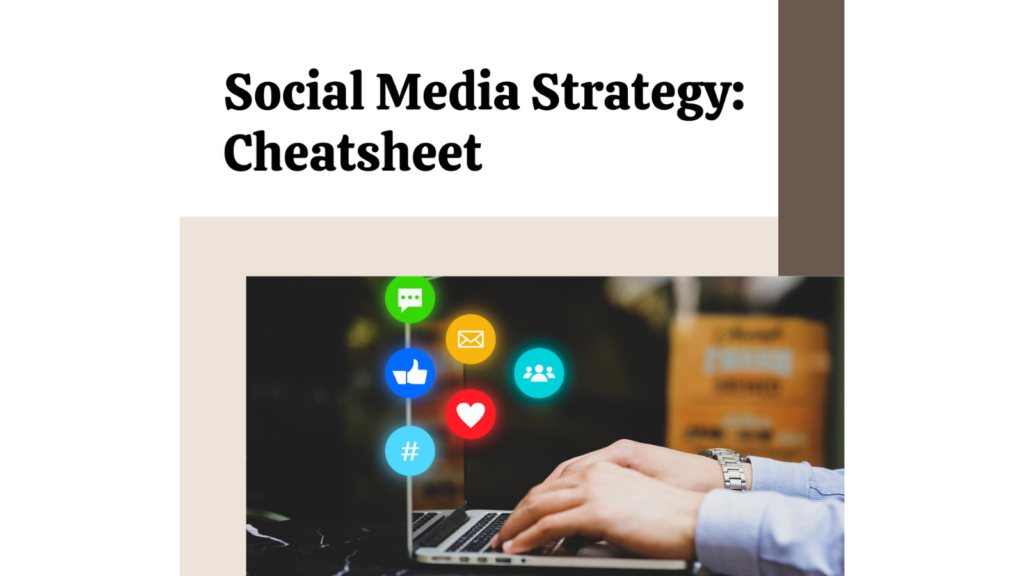Social Media Strategy: The Guide for the Busy Professional

The Importance of Social Media Content
Social media content is a powerful tool to build your brand, establish trust, create viral moments, and motivate your audience to take action. This no-nonsense guide strips away the fluff to deliver actionable insights to kickstart your journey toward a more effective social media strategy. With practical tips and straightforward advice, we empower you to elevate your brand’s online presence confidently and clearly. Let’s dive in and transform your social media approach today!
Types of Social Media Posts
Relationship Posts
- Definition: A Relationship Post is social media content where you share a personal story or experience related to your life or business.
- Purpose: To connect with your audience on a personal level, fostering trust and relatability.
- Example: Share a story of a personal challenge you faced and how it shaped your career, emphasizing growth and resilience.
Social Proof (KLT)
- Definition: Social Proof shows evidence of positive experiences others have had with your product or service. “KLT” stands for “Know, Like, and Trust,” indicating its role in building these factors.
- Purpose: To establish credibility and trust with your audience.
- Example: Share customer testimonials, reviews, or endorsements to showcase your value.
Objection Handling Post
- Definition: An Objection Handling Post addresses common objections or concerns potential customers may have about your product or service.
- Purpose: To empathetically address objections and persuade your audience to overcome their doubts.
- Example: “Worried about the price? Our product might seem costly, but it pays for itself in time saved. Here’s how…”
Tips and Teaching (Expert)
- Definition: Share valuable tips, insights, or educational content about your industry or niche.
- Purpose: To position yourself as an expert and provide value to your followers.
- Example: Create a step-by-step tutorial or a “how-to” video addressing a common challenge in your industry.
Nurture Post (Value)
- Definition: A Nurture Post focuses on providing value to your audience, including inspirational quotes, helpful tips, or enriching information without a direct sales pitch.
- Purpose: To maintain audience engagement and loyalty.
- Example: Share a motivational quote or a quick productivity tip.
Success Story to Relate (VIRAL)
- Definition: This Post features a success story, either your own or a customer’s, designed to be relatable and shareable.
- Purpose: To create viral content that resonates with a broad audience.
- Example: “How a simple idea turned into a million-dollar business. You can do it too!”
Promotional Post (Get Them to Take Action)
- Definition: A Promotional Post is a direct marketing message that encourages specific actions like making a purchase, signing up for a newsletter, or participating in a promotion.
- Purpose: To drive conversions and sales.
- Example: “Limited-time offer: Get 20% off our new product. Grab yours now!”
Additional Post Types to Consider
Behind-the-Scenes Posts
- Definition: Share behind-the-scenes glimpses of your work, office, or creative process to humanize your brand.
- Purpose: Connect with your audience and make them feel more engaged with your team or product.
User-Generated Content (UGC)
- Definition: Encourage customers or followers to create content related to your brand and share it on their social media.
- Purpose: Build trust and authenticity by showcasing real user experiences.
Polls and Surveys
- Definition: Create polls or surveys to gather audience opinions or preferences and interact with them.
- Purpose: To engage the audience and gather valuable feedback.
Interactive Content
- Definition: Develop interactive content like quizzes, contests, or challenges to encourage audience participation and community building.
- Purpose: Increase engagement and foster a sense of community.
Product Spotlight
- Definition: Highlight specific products or services, showcasing their features, benefits, and use cases.
- Purpose: Drive sales and educate your audience about your offerings.
Industry News and Updates
- Definition: Share relevant news and updates within your industry or niche to position your brand as an authority.
- Purpose: Keep your audience informed about current trends and developments.
Customer Testimonials
- Definition: Share testimonials or reviews from satisfied customers to add credibility and social Proof to your brand.
- Purpose: Build trust and showcase the value you provide.
Seasonal and Holiday Posts
- Definition: Create content aligned with holidays, seasons, or special occasions to engage your audience and promote special offers.
- Purpose: Fun engagement and promotional opportunities.
Live Videos
- Definition: Host live streaming sessions for real-time interaction with your audience, such as Q&A sessions, product launches, or event coverage.
- Purpose: Foster engagement and provide valuable real-time content.
Metrics and KPIs for Post-Types
- Relationship Posts: Engagement rate, shares, comments
- Social Proof: Conversion rate, click-through rate
- Objection Handling Posts: Decrease in objection-related inquiries
- Tips and Teaching: Engagement, website traffic, sign-ups for further content
- Nurture Posts: Engagement, audience growth, follower retention
- Success Story Posts: Shares, reach, engagement
- Promotional Posts: Conversion rate, ROI
Call-to-Action (CTA) Examples
- Relationship Post: “Share your similar experiences in the comments!”
- Social Proof: “Click the link to see more success stories.”
- Objection Handling Post: “DM us with your concerns; we’re here to help!”
- Tips and Teaching: “Download our free e-book for in-depth insights.”
- Nurture Post: “Tag someone who needs this motivation today!”
- Success Story Post: “Share this inspiring story with your network!”
- Promotional Post: “Act fast – limited stock available!”
Audience Segmentation
- Tailor your content based on audience demographics, interests, and behavior.
- Example: Create separate content for your B2B and B2C audiences, addressing their unique needs and pain points.
Content Calendar
- Plan and schedule posts strategically to maintain consistency and alignment with your goals.
- Example: Schedule “Tips and Teaching” posts every Tuesday to provide consistent value.
Testing and Optimization
- Continuously test different post types and strategies and analyze data to refine your approach.
- Example: A/B test different headlines in your Promotional Posts to identify the most effective ones.
Compliance and Ethics
- Ensure your content complies with social media guidelines and privacy laws.
- Example: Obtain explicit consent before sharing user-generated content with identifiable individuals.
Content-Length
- Consider platform-specific content length guidelines when crafting posts.
- For example, Twitter limits you to 280 characters, while LinkedIn allows longer-form content.
Engagement Strategy
- Respond promptly to comments and messages, fostering community and trust.
- Example: Reply to comments with personalized responses and engage in meaningful conversations.
Monitoring and Listening
- Monitor social media conversations about your brand or industry to stay informed and engage in relevant discussions.
Competitor Analysis
- Study your competitors’ social media strategies to identify post types and content that resonate with their audience.
- Example: If a competitor’s “Tips and Teaching” post garnered high engagement, consider creating similar content tailored to your audience.
Additional Resources
- Coschedule – https://coschedule.com/
- Hootsuite – https://www.hootsuite.com/
- Buffer – https://buffer.com/
- Social Pilot – https://www.socialpilot.co/
Examples of Effective Posts
- Relationship Post: “When I started my journey as a social media expert, I faced countless challenges. One lesson I’ve learned is never to give up. Share your journey below!”
- Social Proof: “Meet Sarah, a satisfied customer who doubled sales with our product. Read her success story here [Provide Link].”
- Objection Handling Post: “Worried about the price? Our product might seem costly, but it pays for itself in time saved. Here’s how…”
- Tips and Teaching: “🚀 Quick SEO Tip: Use long-tail keywords for better search engine rankings. More tips in our free e-book [Link].”
- Nurture Post: “Tag someone who needs this motivation today! 💪 #MondayMotivation”
- Success Story Post: “Meet John, a self-made entrepreneur who turned his passion into a thriving business. His story inspires us all!”
- Promotional Post: “Act fast – limited stock available! Get 20% off our new product. Grab yours now!”
Remember that the effectiveness of different post types can vary depending on your audience and goals. Analyze your social media analytics to determine which types of posts resonate the most with your followers and adjust your strategy accordingly.
Social Media Strategy: Cheat Sheet
In social media marketing, an effective content strategy is critical to success. Your posts should resonate with your audience, build trust, and drive them to take action. In this guide, we’ll share The intent of posts and explore various types of social media posts and strategies to help you achieve your goals.
If you would like to join us for any of our Webinars, you can learn more at the following;




